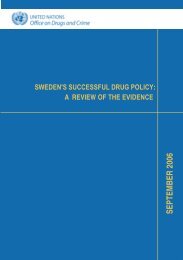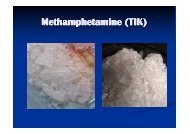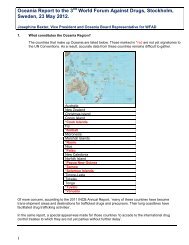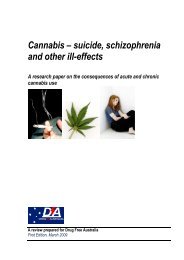International Research Compendium - Drug Free Australia
International Research Compendium - Drug Free Australia
International Research Compendium - Drug Free Australia
Create successful ePaper yourself
Turn your PDF publications into a flip-book with our unique Google optimized e-Paper software.
This craving may inevitably lead addicts to increasingly intense activity to acquire<br />
more of the drug.<br />
The motivation to use drugs, which addicts perceive as drug craving, emanates from<br />
the very same neural structures that give rise to the motivation to seek food, which<br />
everyone perceives as hunger.<br />
The adverse physical consequences of withdrawing from some drugs are viewed as<br />
a key motivational determinant of sustained drug taking through negative<br />
reinforcement mechanisms.<br />
It is possible to have dependence without withdrawal and withdrawal without<br />
dependence.<br />
A person may have cocaine or alcohol dependence, but not to experience withdrawal<br />
symptoms between episodes of use.<br />
The addictive personality as a consequence of drug addiction<br />
The addictive personality consists of 2 different elements:<br />
The Self, which represents the “normal”, human side of the addicted person.<br />
The Addict, which represents the human side that is consumed and transformed by<br />
the addiction.<br />
This personality does not exist prior to the illness of addiction, nor it does represent a<br />
predisposition to addiction. Rather, it emerges from the addictive process, in which<br />
the Addict becomes the dominant personality.<br />
The Addict side within does not care about family and friends. The Addict side<br />
doesn’t care about the Self either. What it cares about is acting out and achieving the<br />
trance.<br />
There is an almost constant conflict between the Self and the Addict when facing the<br />
choice of acting out ( the search for drugs and/or take drugs ) or not. This great<br />
internal tension can go on for hours, days or weeks at a time, and is a large part of<br />
the suffering caused by addiction. But in the end of this struggle, the Addict invariably<br />
wins.<br />
The Self and Addict continue to fight for control: The Self regularly fights and argues<br />
with the Addict, but loses. The Self makes promises to control the Addict, uses<br />
willpower to control the Addict, but loses. We see how the gradual loss of the Self<br />
occurs in addiction, and how the Addict slowly gains more and more control. The Self<br />
witnesses the addictive ritual and is often sickened by what it is forced to participate<br />
in, but it is held captive by the power of the disease of addiction. To fight and struggle<br />
against something that has more power than oneself drains one’s energy. For each<br />
defeat there is some loss of self-esteem.<br />
The Addict develops its own way of feeling<br />
Addiction often creates the sense and sensations of power.<br />
The amphetamine addict who has just shot up feels as if he’s accessed all the<br />
knowledge of the universe. “It made me feel able to do everything.”<br />
The crack addict gets this feeling of power every time he lights up, and the trance<br />
produced is enormously addictive. A cocaine addict testifies: “A coke shot: It’s like…<br />
injectable sex, an orgasm in every cell.”<br />
For the power-centered, drug addicted person, everything flows from the premise of<br />
being right, which gives the illusion of control and bolsters self-confidence, but not<br />
self-esteem. Dedication to power produces a narcissistic and paranoid lifestyle that<br />
21






